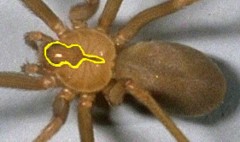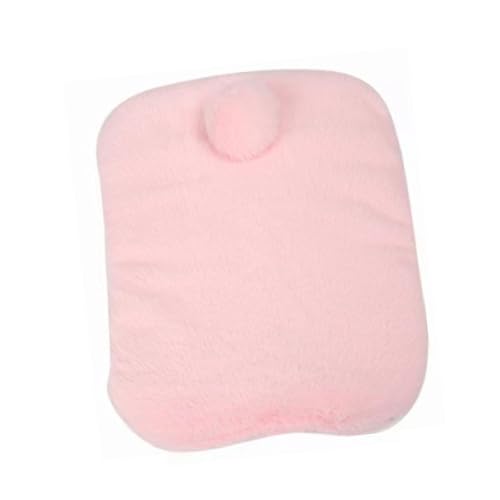You are using an out of date browser. It may not display this or other websites correctly.
You should upgrade or use an alternative browser.
You should upgrade or use an alternative browser.
What kind of spider is this *warning - spider pic*
- Thread starter Leaf
- Start date

Help Support Rabbits Online Forum:
This site may earn a commission from merchant affiliate
links, including eBay, Amazon, and others.
Bo B Bunny
Well-Known Member
:shock:I was always told the UNDERSIDE! WOW I bet I had one in my house a while back!
pamnock
Well-Known Member
This is a good photo that clearly shows the "violin" shape on the back, and also gives a good indication of the size.


pamnock
Well-Known Member
Bo B Bunny wrote:
The black widow has an hour-glass shape on the underside of its abdomen.
Pam
:shock:I was always told the UNDERSIDE! WOW I bet I had one in my house a while back!
The black widow has an hour-glass shape on the underside of its abdomen.
Pam
pamnock
Well-Known Member
Found another good photo - I love spiders 

Photo credit: http://www.spideridentification.org/picture/2.html

Photo credit: http://www.spideridentification.org/picture/2.html
Bo B Bunny
Well-Known Member
pam - you are a crazy woman! 

$10.99
$12.00
KIDS PREFERRED Peter Rabbit Soft Book with toy, Teether and Crinkle, 5 Inches
Amazon.com

$15.60 ($0.03 / Count)
$22.29 ($0.04 / Count)
American Health Original Papaya Digestive Enzyme Chewable Tablets - Promotes Nutrient Absorption and Helps Digestion - 600 Count (200 Total Servings)
Amazon.com

$38.50 ($0.53 / Ounce)
Peter Rabbit Organics Fruit Flavors Variety Pack 4 oz. Squeezable Pouches (Pack of 18)
Amazon.com

$5.49 ($14.64 / lb)
Vitakraft Rabbit Popped Grains & Honey Treat Sticks 2 Pack, 3.0 Ounce
Amazon.com

$8.37 ($0.14 / Count)
$8.99 ($0.15 / Count)
vH essentials Probiotics with Prebiotics and Cranberry Feminine Health Supplement - 60 Capsules
Amazon.com

$9.99 ($42.62 / lb)
CARU - Soft 'n Tasty Baked Bites - Rabbit Bites Dog Treats - Flavorful Training Treats - 3.75 oz
Amazon.com

$7.99 ($0.36 / Count)
$9.98 ($0.45 / Count)
Annie's Organic Berry Patch Bunny Fruit Flavored Snacks, Gluten Free, Value Pack, 22 Pouches, 15.4 oz
Jxsh Store

$8.71 ($0.73 / Ounce)
$9.99 ($0.83 / Ounce)
Brer Rabbit Unsulphured Molasses, Mild Flavor, 12 Ounce
JF Distributions

$3.99 ($31.92 / lb)
Wild Harvest Food And Unique Edible Treats for Guinea Pigs, Hamsters, Gerbils, and Adult Rabbits
Amazon.com

$24.48 ($0.24 / Count)
Urinary Support by Sherwood Pet Health (100 Tablets - 60 Grams)
Sherwood Forest Natural Rabbit Foods

$13.36 ($53.44 / Ounce)
Flower Essence Services Supplement Dropper, Rabbit Brush, 0.25 Ounce
I Buy Direct

$29.46
$45.00
GUND Baby Flora The Bunny Animated Plush, Singing Stuffed Animal Toy for Ages 0 and Up, Cream, 12" (Styles May Vary)
Amazon.com

$36.36 ($0.91 / Ounce)
Pumpkin Tree Peter Rabbit Organics Super Oats & Seeds, Puree Squeeze Pouch, Banana & Mango, 4 Ounce (Pack of 10)
Amazon.com

$14.95 ($0.12 / Ounce)
$16.99 ($0.13 / Ounce)
Kaytee Premium Potty Training Critter Litter for Pet Ferrets, Rabbits & Other Small Animals, 8 lb
Amazon.com
GoinBackToCali
Well-Known Member
Pam as usual is right.. it's the black widow with the underside thing.
Let's not incur the spiders wrath further by popping it a squat upside down..lol
Let's not incur the spiders wrath further by popping it a squat upside down..lol
BlueCamasRabbitry
Well-Known Member
GoinBackToCali wrote:
The only helping hand I would give that spider is from alive to dead - smashed...bam. Then straight into the toilet...at least they'll have water! lol.
Pam, WHY?! Why do you love spiders! i was shivering just looking at those pics that everyone posted! and i picked my feetsies up off the ground. I don't mean to be rude or offensive to any spider lovers, but I kill all spiders i see. ugh....just thinking about them gives me the jeepers-creepers.
Emily
unless a helpful human "lends them a hand."
The only helping hand I would give that spider is from alive to dead - smashed...bam. Then straight into the toilet...at least they'll have water! lol.
Pam, WHY?! Why do you love spiders! i was shivering just looking at those pics that everyone posted! and i picked my feetsies up off the ground. I don't mean to be rude or offensive to any spider lovers, but I kill all spiders i see. ugh....just thinking about them gives me the jeepers-creepers.
Emily
Bo B Bunny
Well-Known Member
Emily I completely agree...... however, I wouldn't be able to put it in the toilet because most likely I would have to be using it cause I'd pee my pants if not! LOL!
When in desperation I have hairsprayed them to death also.
When in desperation I have hairsprayed them to death also.
pamnock
Well-Known Member
Have an eensy weensy spinder under the microscope right now (only a couple mm long).
The dark area near the middle of the photo is a set of eyes. Really cool under my other microscope, but can get them to show up as well with the photo-micro.
Pam
The dark area near the middle of the photo is a set of eyes. Really cool under my other microscope, but can get them to show up as well with the photo-micro.
Pam
GoinBackToCali
Well-Known Member
:threadhijacked:
My apologies Leaf..
I am fond of spiders myself.. there is a spider thats common in these parts. to which there is a funny story that goes along with it..
This lovely fellow makes his web across trails or paths, and you usually end up with him splayed on your face. An ex of mine is deathly afraid of spiders and we went hunting together. So he's all walkin and struttin and being manly with his big gun, and he walks face first into one of these.. he throws down his gun, starts jumpin and flappin and flailin and SCREAMING like a GIRL.. he's screaming for me to do something..
Me? I was literally sitting on the ground with tears in my eyes laughing at the display macho man had put on for me..
My retort? "What ya want me to do about chief? Your the one totin the big gauge*..
He broke up with me..
Here is the lovely bananna spider...

Banana Spider Nephilidae clavipes Banana
Spider Pictures


The golden silk orb weaver, also known as the North American banana spider, is a colorful dramatic spider seen throughout the world. The species we will cover specifically, and the only one seen in North and Central America is nephila clavipes. The golden silk orb weaver is the official banana spider of North America. Some people have chosen to call the argiope garden spider a banana spider, however this is incorrect. It should also be noted that the Brazilian wandering spider (genus phoneutria) has been labeled 'banana spider'.
Identification Guide
My apologies Leaf..
I am fond of spiders myself.. there is a spider thats common in these parts. to which there is a funny story that goes along with it..
This lovely fellow makes his web across trails or paths, and you usually end up with him splayed on your face. An ex of mine is deathly afraid of spiders and we went hunting together. So he's all walkin and struttin and being manly with his big gun, and he walks face first into one of these.. he throws down his gun, starts jumpin and flappin and flailin and SCREAMING like a GIRL.. he's screaming for me to do something..
Me? I was literally sitting on the ground with tears in my eyes laughing at the display macho man had put on for me..
My retort? "What ya want me to do about chief? Your the one totin the big gauge*..
He broke up with me..
Here is the lovely bananna spider...

Banana Spider Nephilidae clavipes Banana
Spider Pictures


The golden silk orb weaver, also known as the North American banana spider, is a colorful dramatic spider seen throughout the world. The species we will cover specifically, and the only one seen in North and Central America is nephila clavipes. The golden silk orb weaver is the official banana spider of North America. Some people have chosen to call the argiope garden spider a banana spider, however this is incorrect. It should also be noted that the Brazilian wandering spider (genus phoneutria) has been labeled 'banana spider'.
Identification Guide
- Primary Colors: The banana spider has varying colors of red, orange, brown, white, and black. The abdomen is usually orange with white spots formed in a near symmetrical pattern.
- Body Characteristics: Overall, the banana spider's body is very large, around 1 to 1.5 inches. The male is very small in comparison, usually 1/5th the size. It is considered one of the largest non-tarantula spiders in North America. The abdomen on a banana spider is a great identifying characteristic. It is long and narrow, often curved like a banana. It is usually reddish brown, and will be covered in white spots. The head is usually gray or white, and can appear to be textured.
- Legs: The legs of a banana spider are very cool! They are quite smooth and hairless, except for the tufts of black spines that appear just before their leg joints. Each of the four front legs usually have two groupings of spines. The two back legs usually have one band of spines each. Also, colored stripes are usually present on the legs. The colors range from a lighter color to a darker color, most often appearing as yellow and red stripes.
- Markings: It is clear that markings are not one of the most important identifying characteristics for the banana spider. Body shape and leg appearance are definitely what to look for. The only significant markings are the white spots speckled all over the abdomen. You will often notice pairs of larger white spots running symmetrically down the center.
- Geographic Location: Found in the southeastern United States, from Texas to North Carolina, usually near the coast. Florida seems to be the most popular state to find the banana spider.
- What to remember: The body shape and legs on this spider are very unique, and not similar to many other common spiders. The banana spider does have some similarities to spiders in the genus argiope, however not enough to cause confusion when making a proper identification.
BlueCamasRabbitry
Well-Known Member
Bo B Bunny wrote:
Ahhh Ahh good idea using hairspray! That is true im always afraid they're not dead and they'll crawl up the toilet (even though its impossible) and bite me! Lol. I just hate spiders. I flip out when i see even the tinsyst (sp?) one!
Emily
Emily I completely agree...... however, I wouldn't be able to put it in the toilet because most likely I would have to be using it cause I'd pee my pants if not! LOL!
When in desperation I have hairsprayed them to death also.
Ahhh Ahh good idea using hairspray! That is true im always afraid they're not dead and they'll crawl up the toilet (even though its impossible) and bite me! Lol. I just hate spiders. I flip out when i see even the tinsyst (sp?) one!
Emily
pamnock
Well-Known Member
BlueSkyAcresRabbitry wrote:
I've loved spiders since I was little. They are so beautiful
Here's our "little" girl (she's as big as my hand) . . .

Pam, WHY?! Why do you love spiders! i was shivering just looking at those pics that everyone posted! and i picked my feetsies up off the ground. I don't mean to be rude or offensive to any spider lovers, but I kill all spiders i see. ugh....just thinking about them gives me the jeepers-creepers.
Emily
I've loved spiders since I was little. They are so beautiful
Here's our "little" girl (she's as big as my hand) . . .

Bo B Bunny
Well-Known Member
:crazinessbeautiful?
BlueCamasRabbitry
Well-Known Member
Ok now see, I like tarantulas. They're really cool and a while ago I used to "own" aspider (without me knowing whatbreed itwas...to no alarm) named Henry, and we were told he was a brown recluse...?? Well once, we were told he was possibly a brown recluse, he was ditched! Although Ithink he was just acommon house spider, and my parents just told me that to scare me and let the poor guy go.lol. But this was about 2 years ago. Anyhow, i like tarantulas - as long as they're no posionous and dont "nip" you when you hold them, etc.
Snakes I just looove Ever been bitten by a garter snake? lol. I have....haha.
Ever been bitten by a garter snake? lol. I have....haha.
Emily
Snakes I just looove
Emily
pamnock
Well-Known Member
BlueSkyAcresRabbitry wrote:
Snakes are fearful creatures. Must be my Gaelic heritage. Hate snakes - love bogs.
Pam
Snakes I just loooveEver been bitten by a garter snake? lol. I have....haha.
Emily
Snakes are fearful creatures. Must be my Gaelic heritage. Hate snakes - love bogs.
Pam
GoinBackToCali
Well-Known Member
Gee, I post a fearful lookin spider pic and an amusing anecdote and I get slighted..
I am crushed
Beside myself...
Inconsolable...
OK i'm over it...LOL
Pam.. you actually had a spider under a microscope? Today?
And I thought I enjoyed strange things..ROFL
I am crushed
Beside myself...
Inconsolable...
OK i'm over it...LOL
Pam.. you actually had a spider under a microscope? Today?
And I thought I enjoyed strange things..ROFL
pamnock
Well-Known Member
GoinBackToCali wrote:
This morning a teeny (nearly microscopic) spider was walking across a white piece of paper. We investigate everything under the scope, so of course, the spider had to be looked at more closely. (It's still there)
Last night, I took the scope to scouts to show them pine tree pollen.
We've also watched cool stuff like body fluids moving through capillaries (in fish tails) - try to get a tiny live fish to stay still under the scope!
Pam
Pam.. you actually had a spider under a microscope? Today?
And I thought I enjoyed strange things..ROFL
This morning a teeny (nearly microscopic) spider was walking across a white piece of paper. We investigate everything under the scope, so of course, the spider had to be looked at more closely. (It's still there)
Last night, I took the scope to scouts to show them pine tree pollen.
We've also watched cool stuff like body fluids moving through capillaries (in fish tails) - try to get a tiny live fish to stay still under the scope!
Pam
cheryl
Well-Known Member
Ewww i hate spiders...they give me the creeps.....i had a huntsman in my bathroom sink two weeks ago...he couldn't get out because it was to slippery for him...i have a hard time killing things now...where as quite a while ago i used to spray them....but if it was something like a red back spider i would kill it because they are quite dangerous....but i was wondering how i was going to get this guy out of my sink...so i thought of my mop...it had a long handle i thought to myself..so i put the bottom of the mop near him and he climbed on and i bolted down the hallway and out the back yard and i chucked that mop with all my might...at least it was outside where he belongs now.
Leaf..that must have been quite a shock for you
Cheryl
Leaf..that must have been quite a shock for you
Cheryl
GoinBackToCali
Well-Known Member
Huntsman spiders freak me out..
We have been to NZ 3 times.. I saw one the first time, and everytime I go back and see something move outta the corner of my eye I am convinced it's a huntsman..
But I must say.. this huntsman was HUGE...
Ok.. now my skin is creepy crawly..
We have been to NZ 3 times.. I saw one the first time, and everytime I go back and see something move outta the corner of my eye I am convinced it's a huntsman..
But I must say.. this huntsman was HUGE...
Ok.. now my skin is creepy crawly..
























































